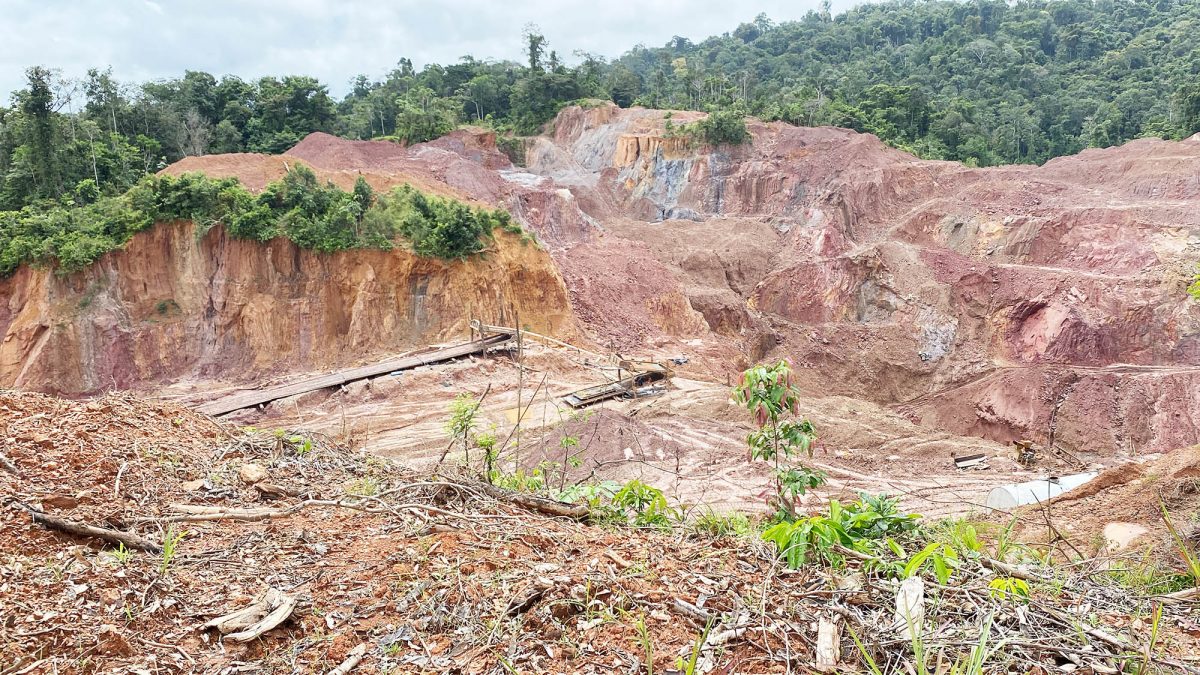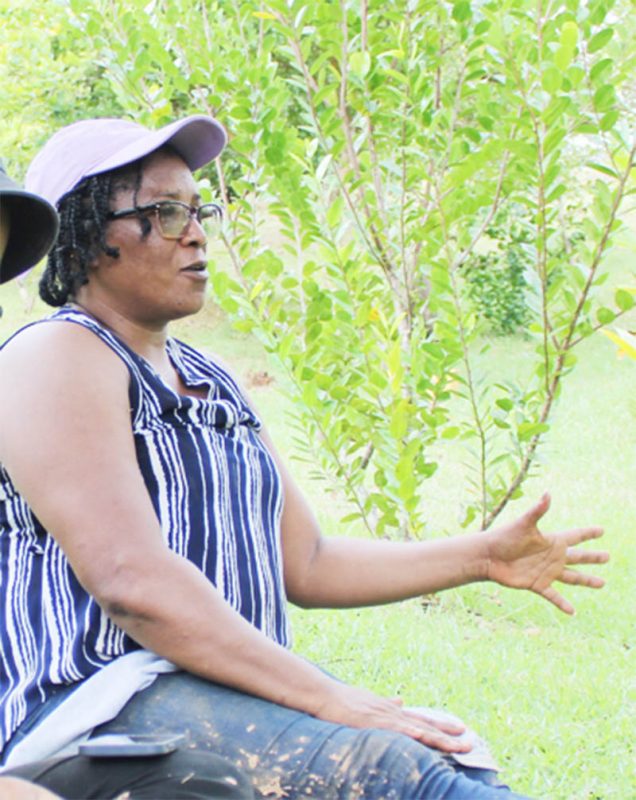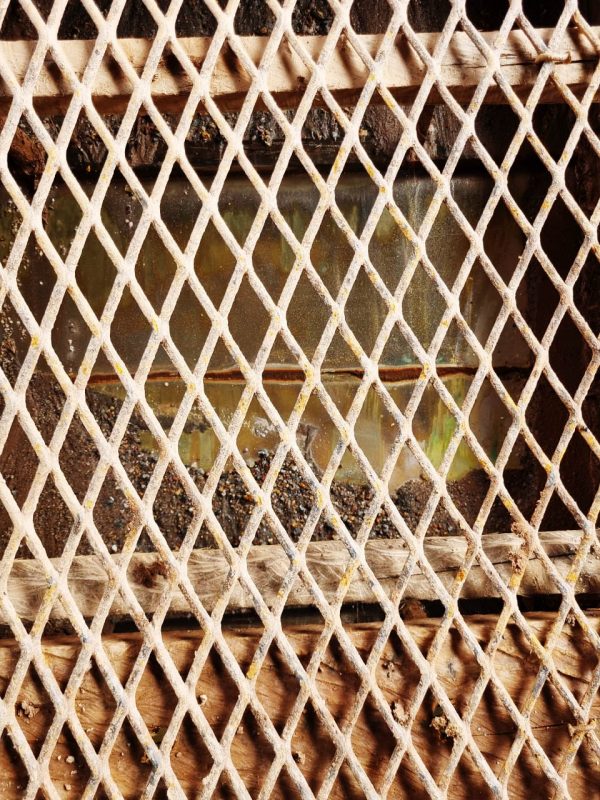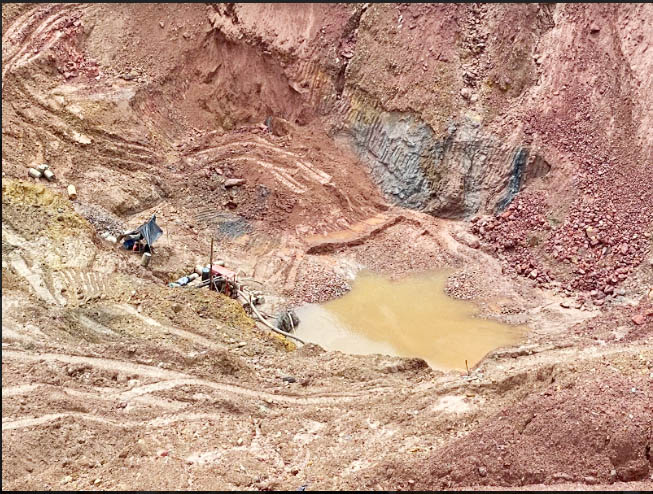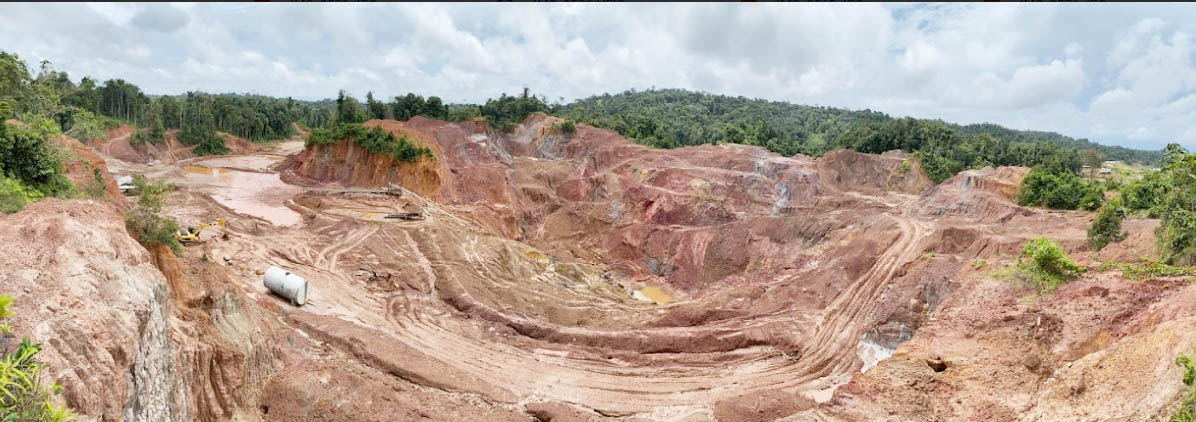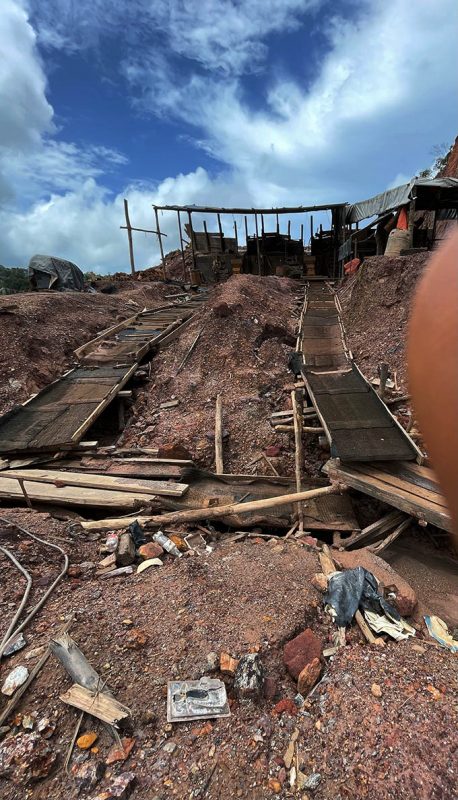Although both the government and the National Toshaos Council (NTC) have promised to send high-level teams into the Region One indigenous community of Chinese Landing to ascertain the level of devastation caused by miners, they have yet to materialise while mining activities have intensified.
The incursion by miners into the indigenous village has been continually raised with various government ministers and successive NTC Executive bodies but the community has not seen any real relief. Its leaders say miners not only threaten the livelihood of the villagers but also blatantly breach the Amerindian Act with help from members of the Guyana Police Force.
Chinese Landing, a Carib indigenous community, is a remote village along the Barama River in the Barima-Waini region and it received its land title in 1976 under then Prime Minister Forbes Burnham. The village received its Certificate of Title on August 10, 2018, for 30.06 square miles or 19,241 acres of land.
Located within the village lands is an area called Tassawini, which is gold-rich and currently occupied by approximately 500 miners according to Toshao Orin Fernandes. They outnumber the village’s population, which stands at just about 210 residents.
Between September 25, 1998, and September 26, 2001, four mining permits were issued to Wayne Vieira, a businessman from Houston, East Bank Demerara, to mine in the Tassawini area. The mining blocks fall in the centre of the community’s titled lands and have been its main source of income from time immemorial. However, since its allocation to Vieira, the community has been engaged in battle with him to regain control. Guyana’s apex court, the Caribbean Court of Justice, has already ruled that Vieira cannot be prevented from mining in the area since he legally owns the blocks there. Just last year, the High Court also dismissed a challenge brought by the community against Vieira. That judgment is currently being appealed.
After the dismissal of the case, the Chinese Landing Village Council approached the United Nations Committee on the Elimination of Racial Discrimination (UN CERD) and complained about a number of violations under the Amerindian Act. The Council had submitted that these violations are being perpetuated by both the government and miners, who were granted permission to operate on titled, customary and sacred lands within their communities.
Contending that the government granted a medium-scale mining concession to Vieira in its titled lands without consulting or seeking the consent of the community, Chinese Landing had informed UNCERD that there has been an increase in unwanted mining which poses a risk to its traditional way of life and its environment. It further alleged that a High Court dismissal, without a hearing, of a claim filed by the community against the Guyana Geology and Mines Commission (GGMC) and Vieira concerning the mining concession has also resulted in an upsurge of a series of incidents of intimidation and assaults on residents of the community, by miners and members of the Guyanese Police Force.
UNCERD, in identifying areas for the government to take measures on, has since proposed consideration be given to suspending or revoking the mining concessions that affect the lands, territories or resources of the Chinese Landing and the Wapichan indigenous peoples until free, prior and informed consent (FPIC) is granted by the indigenous peoples; refraining from approving projects and granting mining permits or concessions within the lands of indigenous peoples, whether titled or not; ensuring that Indigenous Peoples have access to effective and prompt judicial and other remedies to seek protection for their rights; prevent and investigate incidents of threats and violence against residents of the Chinese Landing indigenous community by miners and by members of the Guyanese Police Force; incorporating the principle of FPIC in domestic legislation, including by amending the Amerindian Act of 2006, with indigenous peoples’ participation, and to fully and adequately guarantee the right to consultation of indigenous peoples; and considering ratifying ILO Indigenous and Tribal Peoples Convention (No. 169).
The government, given until July 15 to respond to the CERD, has since submitted its response to the UN but the details are yet to be made public.
Destruction, degradation, prohibition
One of the arguments advanced during the court proceedings, according to the Village Council, is that Tassawini does not form part of the Chinese Landing community. However, according to the village maps which were issued by the Guyana Lands and Surveys Commission, Tassawini is a large chunk of Chinese Landing.
Fernandes said that the village paid $8.1 million to survey its lands and mark the boundaries. Based on its map, Vieira’s concession also falls in part of Koriabo – a nearby community.
Mining is the only source of income for Chinese Landing residents and now they are prohibited from doing that. According to the residents, the Tassawini area has more than double the population of the village, yet not one resident is employed there.
They allege that the operators of Vieira’s concession have restricted Chinese Landing residents from benefitting from the operations. The miners there do not support community businesses nor adhere to community laws. The Amerindian Act expressly states that entry into indigenous communities must be approved by the Village Council, yet the miners operating there refuse to adhere to the law and would intimidate the Council members when they object.
The villagers report that the miners are heavily armed and would be brandishing their weapons to intimidate them. The miners recently took away a phone belonging to a resident, Mikey Miller, after he was using it while traversing the road at Tassawini. It was only retrieved after complaints were made to a visiting Natural Resources Ministry Warden.
While the Village Council can traverse the area, they are not allowed to take photos or videos to document the destruction of their lands.
Stabroek News visited the Tassawini area on Tuesday and the destruction was quite evident. What also stood out was the fact that the toshao had to seek permission to visit the mines from the operators there although it falls within the community. Fernandes explained that it was necessary since the miners had threatened them with prosecution for trespassing on several occasions.
The road leading to the mines has severely deteriorated and according to the Village Council, the residents had been maintaining it because Vieira nor the government is interested in doing so. However, for the past few years, the residents have also been refusing to maintain it since they cannot access the mines nor benefit from the economic activities.
“Our livelihoods have been tampered with and taken away but there has been no free prior and informed consent and we nah get freedom to livelihood because that is our livelihood and in these times it is important for us to educate our children but you need that backings because even if royalty is being paid, you can’t take that royalty from there and support your child, that is village revenue,” the toshao said.
Fernandes said that what also bothers the village is the fact that persons from nearby indigenous communities also bypass the Council and go to work in the mines. They are also setting up shops and providing other services to the miners while the Chinese Landing people are being left out.
During Sunday Stabroek’s visit to the mines, several children were observed in the area, which is prohibited. Also, there are shops directly where mining is happening, which is also prohibited.
“We have all of these shops and children here and the GGMC people and wardens not doing anything about it. This is not supposed to be happening and if it was us doing that then we would have been shut down long time now,” Deputy Toshao Vera Millington said.
Sunday Stabroek, on its visit to the mines, observed that the pit was between 450 and 500 ft deep based on the hill elevation. Fernandes explained that the mining pit is dangerously deep and risks collapsing and causing death. He also questioned why the GGMC would allow the operators to go so deep.
“At this point this can be considered underground mining because this pit is too deep. I am surprised that this haven’t caved in because when this land break away is big boulders coming out. GGMC Officers coming here and saying everything is alright but that is not so and this clearly shows. I haven’t been in the back here for a long time and I am really shocked to see that them man this went so deep,” he said while standing at the top of the hill looking into the pit.
The vice toshao also expressed surprise at the depth of the mines.
“If villagers were there they would have never allowed them to work like that so deep [and] in such a small way because when GGMC come it would have been a problem. But now when GGMC come them ain’t saying nothing because GGMC was in here on Saturday [July 30] and said everything was okay,” she lamented.
Environmental impacts
Mining everywhere, whether done responsibly or not, causes impacts on the environment. At Tassawini the impacts are visible. The miners there are using mercury to extract the gold and it is released into the Tassawini Creek, which flows into the savannahs and into Huri Creek.
“…the tailing [residue from mercury] runs into our big savannah and spread in to there and then it run into the Tassawini Creek and then the Tassawini Creek runs straight into Huri Creek. This Huri Creek is our natural boundary, it runs all the way back to Kariako and then it comes into Barama. So the tailing whatever you use there it has to run into Huri Creek even if you bar it off and it break away it runs straight into Huri Creek and into Barama,” Fernandes explained.
Those creeks and savannah are the fishing grounds for Chinese Landing people as well as their main water sources. Now they are forced to look at alternatives owing to the pollution from mining.
Fernandes said that just over a year ago, a mercury test showed above-normal levels in his body and he was on treatment for a week. He has not done another test since then. He said that the children are constantly in the water swimming which means that they are also ingesting it. He is now concerned about the effects of this on their bodies.
The village leader also said that officers from the Environmental Protection Agency (EPA) visited the community once but they never heard anything about the findings. He is calling for more visits and the implementation of stringent measures against the destruction of the environment.
“I would say yes [that EPA should come in and do some work] because continuing to poison out the place, it’s not healthy. Whether it comes from the village people or miners and it will affect ourselves and the little ones coming up,” he said.
No visits, no action
The Amerindian Act of 2006 mandates that any mining within an indigenous community should occur after the FPIC process has been exhausted as well as an agreement entered into with the Village Council’s permission. Those steps were not taken, according to toshao Fernandes, when Vieira received permission to begin prospecting back in 1995.
Last month, newly elected Chair of the NTC toshao Derrick John told Stabroek News that President Irfaan Ali informed him that a team was sent to the Chinese Landing community to meet with the miners and villagers in order to assess the situation.
“The President sent out a team to [meet] with the miners at Chinese Landing and I think there were measures that was put in place to address some of those concerns. So I really appreciate that. I spoke to the President, I think was on Thursday, and he said that the team was there to do more investigations,” the NTC Chair had said during an interview with Stabroek News.
On Monday, Sunday Stabroek travelled to the Chinese Landing community where it spoke to a number of residents and also visited the mines.
Toshao Fernandes told this publication that to date no high-level team has visited. He said that he has taken note of the NTC Chair’s statement about a team already visiting as well as the claim that the mining issues at Chinese Landing and other communities are priority issues for the newly installed NTC Executive.
“NTC in the past – I won’t say I don’t have confidence in them, I would say there was no help really for Chinese Landing. We learn that from the past and now we have a body that saying that these are the priority issues – Chinese landing and Isseneru case but from past we haven’t been receiving any help from the NTC. Now today I am pretty sure it might be the same because even hearing from the Chair about teams visiting and all of these things happening already and you come today [Monday] and know that nothing like that never happened. A lie in the public, I don’t see where that is going at any moment,” Fernandes said.
John, who is the toshao of Moraikobai in Region Five, was elected as NTC Chair on July 11 during the National Toshaos Conference.
When asked whether any discussion has happened between himself and the newly elected Chair, Fernandes replied in the negative. He explained that while he was in Georgetown for the conference, John did not offer to engage him on issues and how to move forward with representation.
During the conference, Fernandes and his team has a brief engagement with President Ali, Vice President Bharrat Jagdeo – who was president at the time when the blocks were issued – and Minister of Natural Resources Vickram Bharrat.
Fernandes told Sunday Stabroek that they related everything that is happening in the village to the three leaders. He related that they also informed the President and his team of the airstrip that was established by persons operating Vieira’s claims while expressing concerns about the persons blatantly violating the community’s rights.
“Their response was like they said alright toshao we hear you and we know the situation and so on but what you suggest and I said that we have always been asking relocate Mr Wayne Vieira. [The] VP said that we can’t do that now. He said due to the court ruling, the CCJ ruling, they said we can’t do that but what they can do is that they can send in a team, a team of soldiers, police, GGMC [Guyana Geology and Mines Commission Officers], wardens from Natural Resources. He called it a power team to come on the ground and anybody who they find without documents or out a line with any permission or whatever will be brought before the courts, that was his [Jagdeo’s] very words,” Fernandes reported.
However, he related that they informed the Vice President that sending a team does not change the fact that the miners will still be there and operating as usual. He said that they informed the government that while officials from GGMC and the Natural Resources Ministry would visit, the miners are always tipped off prior or they would pay a bribe to the officers.
“Minister [Bharrat] agreed and minister said we are aware of that and we understand that. He said toshao I will let you know directly when the team is coming and that even if the message go out that the team is coming and they hide up their stuff, they still have to bring it out back. So they didn’t set a date with us but that’s what they promised and we still hope and believe they will do that but then again sending a team just to come and inspect and whatever [makes no difference]…it is hard to have illegal miners working out the resources when the village should be benefitting off of that,” the toshao said.
He added that they also related that when the concession was granted to Vieira in 1995, the village was not consulted although it had a functioning council at the time.
“Then free prior and informed consent was never applied and this is something the government boasts about that free prior and informed consent is being applied to indigenous communities but we learn in our case that it was not so,” he lamented.
Just before the Toshaos Conference, Minister of Housing and Water Collin Croal visited the community and held a meeting with residents there. All of the mining issues were raised along with other concerns to which he promised to have the government address. However, according to residents they have not heard nor seen the minister again.
The residents there also expressed that they feel as though they have been forgotten not by just the government at large but particularly by Minister of Amerindian Affairs Pauline Sukhai. They lamented that while she is tasked with representing their rights and being their voice in government, there has been little or no communication from her regarding the situation.
Even at the conference, she did not seek to engage the leaders nor call for their cause to be addressed.
“I lose hope again but not in a sense of giving up or anything but knowing that even though the government is there and they have been asked to do certain things in our favour, it is like I can say to a certain point is like they didn’t check in on us or are concerned to fix anything,” the toshao said.
The villagers reported that Minister Sukhai visited the community once and that was several years ago. They said that during an engagement with her at a forum, the minister was wholly unaware of the development in the village as well.
“She [Sukhai] told me that it is better for the people of Chinese landing to get an agreement than for the people to live in [tar]paulin camps and I didn’t answer her. A person from APA [Amerindian Peoples Association] answered her and told her that minister what you are saying there was then, today go back Chinese Landing and see what is taking place,” Fernandes explained.
Sunday Stabroek attempted to reach Sukhai and Bharrat but was unsuccessful.
Buyout
In August of 1999, the Village Council at the time entered into an agreement with Vieira where he was permitted to mine on its land in exchange for 1% royalty. However, Vieira continually breached the agreement and it was terminated on April 27, 2004.
According to Fernandes, back then the village leaders did not understand their rights. He said that they mostly spoke the Carib language so that also served as a barrier.
Deputy toshao Millington told Sunday Stabroek that she was a teacher in the village at the time and would attend most of the meetings. While at one of those meetings with Vieira, he was there attempting to exchange the royalty for the renewal of the agreement.
She explained that she was part of a workshop for the revision of the Amerindian Act and was fairly knowledgeable of the rights granted under the law and it was then that she stood up and objected.
“I say man I can’t allow this to go just like that. You know just to allow them to continue riding these people in this sort of manner and then I start answering them at that said meeting because like he [Vieira] brought in some royalties and he brought a document telling them [Village Council] if you sign this document, I will give you this money and it was like a buyout.
“It was like you don’t sign this document, you don’t get this money and I became so angry. I stand up and I said that money you are bringing there, they don’t have to sign that document [because] by right that is their money because that is the royalty that you have already worked and they don’t have to sign that document and if you want to leave that money, you will leave it but they are not signing that document and that is where everything started,” Millington explained.
She said after that she went on to serve as toshao and has been on several Village Councils while advocating for the rights of Chinese Landing. The village never entered into another agreement with Vieira.
According to toshao Fernandes, Vieira still owes the community unpaid royalties from the agreement. He added that they would not explore another agreement with Vieira and would prefer access to their own lands.
He added that the issue could have been resolved a long time ago if the previous councils were knowledgeable about their rights and stood their ground against the invasion.
The community of Chinese Landing remains adamant that the government issued the mining permits in contravention of the laws and they should be revoked. However, they are also aware of the government’s refusal to revoke the permits.
“It doesn’t look like this will be an issue of the past because for sure you can’t fight the government and it’s the government that is in power [the PPP/C] that sold the land. And if over the years they wanted to do something even, if it was a genuine mistake on their behalf, they would have done it. I have seen from the beginning when [former Prime Minister] Sam Hinds was in charge of mining, I have seen [former Minister of Natural Resources] Robert Persaud – for him he tried. I [also saw] now Vice President, he was president at that time, Jagdeo and all of those people and if they always know that this was an issue and if there was any genuine concern then since then they would have tried to fix it,” vice toshao Millington said.
She also said that the miners operating in the village boast about their connections to the government and they are supported by the Police.
For now, the community of Chinese Landing is waiting to see what the next step that UN CERD recommends and is also hoping that government can act. They have also written to CERD, after the July 15 deadline set for government to respond to the CERD, informing that no action has been taken by the government.

